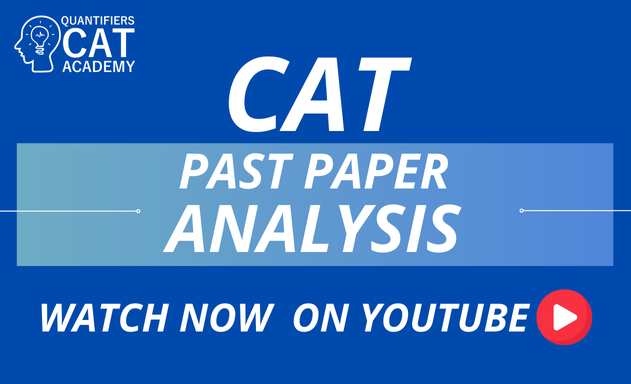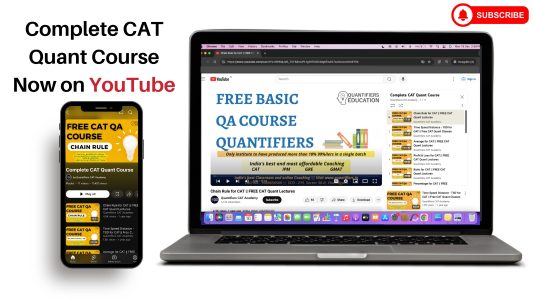Welcome to the CAT 100 Day Challenge
(Day 61-100)
100 days. 100 questions. One shot at your IIM dream.
The CAT exam isn’t cracked in one night—it’s conquered through daily consistency. That’s why we created the CAT 100 Day Challenge: a free prep journey where you solve one high-quality CAT-level question every day, complete with solutions, shortcuts, and expert tips. In less than 10 minutes a day, you’ll build unstoppable momentum, sharpen your skills, and stay exam-ready without overwhelm. Whether you’re starting late or fighting procrastination, this challenge is your daily push to stay disciplined, focused, and ahead of the competition.
Start today. One question → one habit → one step closer to your IIM seat.
CAT in 100 Days
Day 61 of 100: Quant - Geometry
RS is a rectangle with PR as one of its diameter and PR + PQ = 5PD and PR – PS = 8. The area of the rectangle is:
- 40
- 50
- 60
- 75
Correct Answer
C. 60

Day 62 of 100: DILR Set

Q1. Reshma got calls from all the institutes. What could be the minimum marks obtained by her?
Q2. Atul got calls from two institutes. What could be the minimum marks obtained by him in a section?
Q3. Amol did not get a call from even a single institute. What could be the maximum aggregate marks obtained?
Q4. Ramesh got calls from two institutes. What could be the maximum aggregate marks obtained by him?
Correct Answer 1
362
Correct Answer 2
50
Correct Answer 3
370
Correct Answer 4
383Day 63 of 100: VARC - Summary
The passage given below is followed by four alternate summaries. Choose the option that best captures the essence of the passage.
In recent years, there has been a surge in the acclaim for electric vehicles (EVs) as a greener alternative to traditional gasoline-powered cars, with the potential to mitigate environmental damage. However, emerging research has shed light on a hidden environmental cost associated with EVs, stemming from their tires. Specialists have raised concerns that tires, a component frequently overlooked in environmental discussions, are a significant source of chemical and micro-plastic pollution. Specifically, tires from electric vehicles have been identified as particularly problematic, producing up to 20% more pollution than those on gasoline vehicles. A major contributor to this increased pollution is the intrinsic characteristics of EVs; they are generally heavier and have faster acceleration than gasoline-powered vehicles, which leads to a greater release of tiny particles into the air as the tires wear down.
- EV tires produce up to 20% more pollutants than those of gasoline vehicles due to their weight and acceleration.
- Electric vehicles are generally heavier and accelerate faster than gasoline vehicles, impacting tire wear.
- Pollution from electric vehicles is an overlooked environmental issue contributing to chemical and micro-plastic pollution.
- The acclaim for electric vehicles as a greener alternatives overlooks the significant pollution caused by their tires.
Correct Answer
4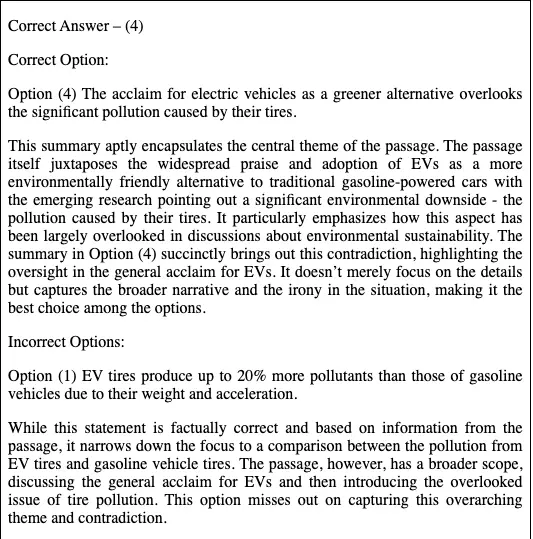
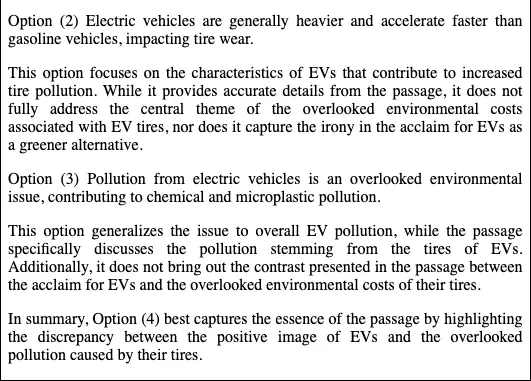
Day 64 of 100: Quant Tip - Prioritize Algebra and Arithmetic Foundations 🔢
Statistically, Arithmetic (percentages, profit/loss, TSD, work/time) and Algebra (functions, inequalities, equations) form the largest portion of the CAT syllabus (often ≈60−70% of the section). Ensure these concepts are not just understood but are drilled to an automatic level.
Mastery here guarantees the bulk of the score. Unlike Geometry or Number Systems which can sometimes throw a rare, complex question, Arithmetic and Algebra are typically direct application of formulas and concepts.
Day 65 of 100: DILR Set
The following table represents addition of two six-digit numbers given in the first and the second rows, while the sum is given in the third row. In the representation, each of the digits 0, 1, 2, 3, 4, 5, 6, 7, 8, 9 has been coded with one letter among A, B, C, D, E, F, G, H, J, K, with distinct letters representing distinct digits.

Q1. Which digit does the letter A represent?
Q2. Which digit does the letter B represent?
Q3. Which among the digits 3, 4, 6 and 7 cannot be represented by the letter D?
Q4. Which among the digits 4, 6, 7 and 8 cannot be represented by the letter G?
Correct Answer 1
1
Correct Answer 2
9
Correct Answer 3
7
Correct Answer 4
6
Day 66 of 100: VARC Vocabulary
Word: Verbosity (noun)
Meaning: The quality of being wordy; using or containing too many words.
Example in a Sentence: “The editor was forced to cut several paragraphs from the article to reduce its unnecessary verbosity.”
Synonyms: Wordiness, long-windedness, prolixity, garrulousness.
Why it’s important: Understanding this term is key to appreciating the value of concise and effective communication. It highlights a flaw in writing or speaking where clarity is obscured by an excessive use of words, a point often critiqued in composition and rhetorical analysis.
Day 67 of 100: Quant - Permutation and Combination
A question paper consists of 5 problems, each problem having 3 internal choices. In how many ways can a candidate attempt one or more problems?
- 63
- 511
- 1023
- 15
Correct Answer
C. 1023
Given that, the question paper consists of 5 problems. For each problem, one or two or three or none of the choices can be attempted. Hence, the required number of ways = 45-1 = 210 - 1= 1024 - 1 = 1023.
Day 68 of 100: DILR Set
XYZ Ltd. conducted an online exam and selects 150 candidates for a research project. Each of the selected candidates can be classified as having either a good or an average academic record, as freshers or as having work-experience, as B.Sc. graduate or B. Stat graduate. It is further known that the number of candidates with work experience is half the number of freshers. The number of candidates who are B. Stat is twice those who are B.Sc. graduates. The number of freshers having a good academic record is same as the number of B.Sc. candidates having a good academic record. The number of B.Sc. graduates with work-experience and an average academic record is one more than the number of B. Stat graduates who are freshers and have a good academic record. The number of candidates with an average academic record is 54 more than those with good academic record.
Q1. What is the difference between the number of B. Stat graduates who have work-experience and an average academic record, and the number of B.Sc. graduates who are freshers and have a good academic record?
- 0%
- 2%
- 8%
- 10%
Q3. If 16.67% of the number of candidates with an average academic record are B. Stat candidates with work experience, find the number of B.Sc. graduates who are freshers and have a good academic record.
Q4. If the number of B.Sc. graduates who have an average academic record and are experienced is the minimum possible, then which of the following can be the number of freshers with an average academic record?
51
100
101
Any of the above
Correct Answer 1
1
Correct Answer 2
D. 10%
Correct Answer 3
16
Correct Answer 4
B. 100
Day 69 of 100: VARC Reading Comprehension
I am of opinion that persons such as you, to whom fortune and reason have committed the charge of public affairs, are not more inquisitive in any point than in ascertaining the character of those in office under you, for no society is poorly furnished, but that, if a proper distribution of authority be used, it has persons sufficient for the discharge of all official duties; and when this is the case, nothing is wanting to make a State perfect in its constitution. Now, in proportion as this is so much to be desired, so it is the more difficult of accomplishment, since you cannot have eyes to embrace a multitude so large and so widely extended, nor to see to the bottom of hearts, in order that you may discover intentions and consciences, matters principally to be considered, so that there has never been any commonwealth so well organised, in which we might not detect often enough defect in such a department or such a choice and in those systems where ignorance and malice, favouritism, intrigue, and violence govern, if any selection happens to be made on the ground of merit and regularity, we may doubtless thank Fortune, which, in its capricious movements, has for once taken the path of reason.
This consideration, Monseigneur, often consoled me, when I beheld M. Etienne de la Boetie, one of the finest men for high office in France, pass his whole life without employment and notice, by his domestic hearth, to the singular detriment of the public, for so far as he was concerned, I may assure you, Monseigneur, that he was so rich in those treasures which defy, fortune, that never was man more satisfied or content. I know, indeed, that he was raised to the dignities connected with his neighbourhood-dignities accounted considerable, and I know also, that no one ever acquitted himself better of them; and when he died at the age of thirty-two, he enjoyed a reputation in that way beyond all who had preceded him.
But for all that, it is no reason that a man should be left a common soldier, who deserves to become a captain, nor to assign mean functions to those who are perfectly equal to the highest. In truth, his powers were badly economized and too sparingly employed, insomuch that, over and above his actual work, there was abundant capacity lying idle which might have been called into service, both to the public advantage and his own private glory.
Therefore, Monseigneur, since he was so indifferent to his own fame for virtue and ambition, unfortunately, seldom lodge together), and since he lived in an age when others were too dull or too jealous to witness to his character, I have I marvellously at heart that his memory, at all events, to which I owe the good offices of a friend, should enjoy the recompense of his brave life and that it should survive in the good report of men of honour and virtue. On this account, sir, I have been desirous to bring to light, and present to you, such few Latin verses as he left behind. Different from the builder, who places the most attractive portion of his houses towards the street, and to the draper, who displays in his window his best goods, that which was most precious in my friend, the juice and marrow of his genius, departed with him, and there have remained to us but the bark and the leaves.
The exactly regulated movements of his mind, his piety, his virtue, his justice, his vivacity, the solidity and soundness of his judgement, the loftiness of his ideas, raised so far above the common level, his learning, the grace which accompanied his most ordinary actions, the tender affection he had for his miserable country, and his supreme and sworn detestation of all vice, but principally of that villainous traffic which disguises itself under the honourable name of justice, should certainly impress all well-disposed persons with a singular love towards him, and an extraordinary regret for his loss. But, sir, I am unable to do justice to all these qualities, and of the fruit of his own studies it has not entered into his mind to leave any proof to posterity; all that remains, is the little which, as a pastime, he did at intervals.
However this may be, I beg you, sir, to receive it kindly; and as our judgment of great things is many times formed from lesser things, and as even the recreations of illustrious men carry with them, to intelligent observers, some honourable traits of their origin, I would have you form from this, some knowledge of him, and hence lovingly cherish his name and his memory. In this, sir, you will only reciprocate the high opinion which he had of your virtue, and realise what he infinitely desired in his lifetime, for there was no man in the world in whose acquaintance and friendship he would have been so happy to see himself established, as in your own. But if any man is offended by the freedom which I use with the belongings of another, I can tell him that nothing which has been written all over laid down, even in the schools of philosophy, respecting the sacred duties and rights of friendship, could give an adequate idea of the relations which subsisted between this personage and myself.
Moreover, sir, this slender gift, to make two throws of one stone at the same time, may likewise serve, if you please, to testify the honour and respect which I entertain for your ability and high qualities, for as to those gifts which are adventitious and accidental, it is not my taste to take them into account.
- The author was a secret admirer of the dead man.
- They were strangers to each other.
- They were fast friends.
- They had worked together.

- For an apology on not having done right by his dead friend, when he was alive.
- For monetary compensation for the death of his talented friend.
- For the commemoration of his dead friend’s death.
- For the honoring and acknowledgment of the talents of his dead friend.

- Highly encouraging
- Highly adulatory
- High strung
- Nonchalant

Q4. What would the author most likely think of an ambitious person?
- That he/she was talented
- That he/she was lacking in virtue
- That he/she was indifferent to fame
- That he/she was gifted

Correct Answer 1
Option CCorrect Answer 2
Option D
Correct Answer 3
Option B
Correct Answer 4
Option B
Day 70 of 100: Quant - Probability
If A and B are two equally likely events and the probability of the event B happening is 3/4, then the probability that event A does not happen is:
- 3/4
- 1/4
- 2/3
- 1/3
Correct Answer
B. 1/4
Since A and B are equally likely events P(A) = P(B) = P
Day 71 of 100: DILR Tip - Practice Visualization and Sketching 📝
For arrangement (linear/circular), distribution, and matrix-based sets, always draw a clean grid or sketch. Don’t try to hold complex arrangements in your head. For sets like Games and Tournaments or Network Diagrams, quickly drawing the connections and paths is non-negotiable.
Visualization minimizes careless errors, helps you spot impossible arrangements faster, and makes it easier to track the placement of variables across multiple cases.
Day 72 of 100: VARC Verbal Reasoning
DIRECTIONS for questions: In each of the questions a statement is followed by two assumptions. These assumptions may or may not be implicit in the statement. Identify the assumption implicit in the statement and mark your response in accordance with the following code:
- only assumption I is implicit
- only assumption II is implicit
- both assumptions I and II are implicit
- neither assumption I nor II is implicit
Q1.
Statement:
Assumptions I: Non living beings are not social animals.
Assumptions II: There is at least one more living being other than man.
The statement talks about living beings only. Nothing can be assumed about non-living on the basis of the given statement. So, it is not correct to assume I. Option II is definitely true as without this being true the statement will not hold good. Option (b) is correct.
Q2.
Statement:
Child abuse is increasing and has become a major form of human exploitation in India.
Assumptions I: Children can be subjected to abuse and exploitation in India.
Assumptions II: Other forms of human sexploitation exist in India.
Both the assumptions are correct as without them the argument will not be supported. As child abuse is increasing, statement I is definitely true. 'A major form of human exploitation in India' indicates that it is not the only form of human exploitation in India.
Q3.
Statement:
Teachers have observed that children respond better in a situation where a variety of activities are taking place than in a situation with a single activity.
Assumption I: Teachers keep track of the activities of children.
Assumption II: Children take part in various activities.
Assumption I is true as without it teachers will not be able to make such an observation. Assumption II is clearly implied by the given statement in question because it states that children respond in a better way only when they find more variety. Hence, children take part in various activities.
Q4.
Statement:
People in North India wear more woollens than people in South India.
Assumption I: Good quality woolens are available more in North India than in South India.
Assumption II: People of North India are not as strong as people of South India.
Both the assumptions do not hold good. Quality of woolens does not justify the need of using them more. No assumption regarding the strength of people can be made on the basis of the need for woolens. The need depends upon climate. Thus, the valid assumption is that the climate of North India is colder than that of South India.
Q5.
Statement:
Assumption I: Personality trait is a measurable entity.
Assumption II: Personality traits are important factors with respect to performance of the job.
Assumption I is valid as it would not have been possible to measure the personality traits if it had not been a measurable entity. Since UPSC has made it a routine to measure the personality traits of the candidates, it must be important for them to measure the personality traits; hence assumption II is valid. Hence, both the assumptions follow.
Correct Answer 1
B
Correct Answer 2
C
Correct Answer 3
C
Correct Answer 4
D
Correct Answer 5
C
Day 73 of 100: Quant - Ratio & Proportion
The mean proportional between two numbers is 9 and the third proportional of the two numbers is 243. Find the larger of the two numbers.
- 27
- 81
- 9
- 54
Correct Answer
A. 27

Day 74 of 100: DILR Set
In the following 3 x 3 grid, each cell has a distinct letter from among a to i. These nine letters are distinct single digit natural numbers.
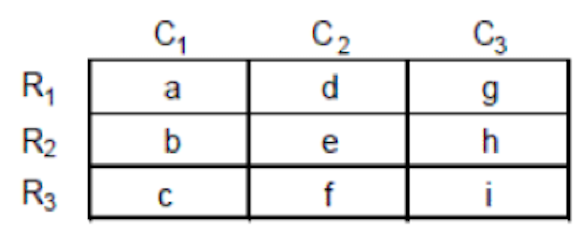
- The product of the numbers in row R3 is twice their sum. The same is also true for column C2.
- Except column C1, every column has exactly one even number
- The six digit number ‘fdbieh’ when multiplied by 3 gives ‘dbiehf’.
- 6
- 9
- 2
- 7
- 120
- 160
- 96
- None of these
Q3. The absolute difference of values of g and d is equal to the value of
- b
- e
- c
- i
Correct Answer 1
A. 6Correct Answer 2
C. 96
Correct Answer 3
B. e
Day 75 of 100: VARC Vocabulary
Word: Intrepid (adjective)
Meaning: Feeling no fear; adventurous and bold.
Example in a Sentence: “The intrepid explorers set out to cross the uncharted desert, facing great dangers with unwavering resolve.”
Synonyms: Fearless, dauntless, brave, valiant, audacious.
Why it’s important: This is a strong descriptor used to characterize heroes and individuals who display courage in the face of extreme difficulty or peril. It’s often used in narratives focusing on exploration, adventure, and overcoming monumental challenges.
Day 76 of 100: Quant - Time, Speed & Distance
M and N are two points that are 8m apart. Anand and Ajay started simultaneously from M and N respectively. Anand moved towards N at 3 m/sec. Ajay moved towards M at 5 m/sec. After reaching their destinations, both turned back at their original speeds towards their starting points. Find the total distance (in m) that Ajay would have travelled before crossing Anand for the second time.
- 12
- 13
- 15
- 14
Correct Answer
C. 15Anand and Ajay would meet for the first time during their onward journeys. They would meet for the second time during their return journeys. Time taken by Anand to travel from M to N = 8/3 seconds. Distance travelled by Ajay in this time = 8/3 x 5 = 40/3 m. So, he would be 40/3 - 8 = 16/3 m from N when Anand reached N. So, the distance between them would then be 8 - 16/3 = 8/3 m Anand would cross Ajay in another (8/3)/8 = 1/3 seconds. Therefore, Ajay would have travelled a distance of 40/3 + 1/3 x5 = 45/3 = 15 m when he crossed Anand for the second time.
Day 77 of 100: DILR Set
Five girls and four boys of a class were to be sent for a sports camp. Their teacher was asked to measure the weight of these students but the weighing machine available in the school was defective and only measured weights greater than 100 kg. Hence, the school decided to measure the weight of three students at a time, but all three students selected would be of the same gender. He took all the possible weight combinations of girls as well as of boys. For girls, the measurements were 122 kg, 127 kg, 130 kg, 132 kg, 133 kg, 134 kg, 137 kg, 138 kg, 142 kg, 145 kg. For boys, the measurements were 174 kg, 170 kg, 165 kg and 163 kg. No two boys or no two girls had the same weight.
- 50.33 kg
- 48.22 kg
- 51.44 kg
- 49.67 kg
Q2. What is the difference in the weights of the second heaviest boy and the second lightest girl?
- 14 kg
- 15 kg
- 18 kg
- 20 kg
- 54 kg
- 56 kg
- 59 kg
- 61 kg
- 5
- 4
- 3
- 2
Correct Answer 1
D. 49.67 kg
Correct Answer 2
C. 18 kg
Correct Answer 3
D. 61 kg
Correct Answer 4
B. 4
Day 78 of 100: VARC - Odd One Out
Five sentences related to a topic are given below in a jumbled order. Four of them form a coherent and unified paragraph. Identify the odd sentence that does not go with the four. Key in the number of the option that you choose.
- But we haven’t managed to decipher it yet, so we don’t know who they were, where they came from, what kind of social organisation or rulers they had, what language they spoke, or even what their names were.
- The best globally accepted theory of Indo-European language spread is that proto-Indo-European, was spoken in the Pontic Steppes in Central Asia by horse riding, chariot-driving pastoralists.
- The fault doesn’t lie with the remarkable men and women who built the Indus valley civilization – what was easily the largest civilization of their time.
- Although this question has always been asked, the correct answer to it has proved resistant to the wiles and charms of historians, archaeologists, linguists and philologists for nearly a century.
- They had a script of their own and they left behind enough of their writings on tablets, seals, tools, pottery, and ornaments.
"But we haven't managed to decipher it yet.." in sentence 1 is related to "They had a script of their own and they left behind enough of their writings on tablets..." in sentence 5. So, sentences 5 and 1 are related. "They" in sentence 1 must refer to "the remarkable men and women who built the Indus valley civilization". Thus, sentence 3 is also related to the narrative. We can try to relate sentences 4 and 2 to the narrative about Indus valley civilization. Sentence 4 serves as an introduction to the narrative. 4351 explains that we know nothing about the Indus valley civilization inspire of the civilization leaving behind enough clues. We are just unable decipher them. Sentence 2 cannot be related to this theme. Hence, 2.
Correct Answer
2
Day 79 of 100: Quant - Variation
The speed of a locomotive without any wagons attached to it is 40 kmph. It diminishes by a quantity which is proportional to the cube root of the number of wagons attached. If the speed of the locomotive is 34 kmph when 27 wagons are attached, what is the maximum number of wagons that can be attached if the condition is that the speed should not fall below 30 kmph?
- 64
- 125
- 216
- 343
Correct Answer
B. 125

Day 80 of 100: DILR Set
The function ‘Difference (N)’ takes a non negative integer N as a parameter and returns the absolute difference of N and the number obtained by reversing the digits of N. For a two digit natural number X with distinct digits, a set of six non negative integers {P, Q, R, S, T, U} is defined such that P = Difference(X), Q = Difference (P), R = Difference (Q), S = Difference (R), T = Difference (S) and U = Difference (T)
Q1. If the value of T is not equal to zero, then what is the largest possible value for X?
- 86
- 90
- 68
- None of these
Q2. If d is the difference between the two digits of X and d = 4, then what is the sum of P, Q, R, S, T and U?
- 128
- 117
- 136
- 158
Q3. For any value of X, what is the maximum possible sum of T and U?
Q4. If X is greater than 50, then what is the maximum possible value of U?
Correct Answer 1
D. None of theseCorrect Answer 2
B. 117Correct Answer 3
9
Correct Answer 4
0
Day 81 of 100: VARC Reading Comprehension
The passage given below is followed by a set of questions. Choose the most appropriate answer to each question.
I enjoy philosophy because it gives me direction. Though it doesn’t always tell me what I want to know, it reveals what I ought to know. Following are five short, philosophy lessons that have guided me in asking the right questions in life.
How things affect us depends on how we feel about them. How we feel about them depends on what we believe they mean. Our mind is our home. It’s where we live. However, our world is an unpredictable jungle of chaotic events scrambling our home like uninvited wild animals. The only real control we have in this ever-changing world is in our home; what we permit in, where we put it, and how we use the meanings we give it to tame it.
Formulating meanings and opinions is important, but just like a bowl that isn’t hollow, can’t hold water, a mind that isn’t free of preconceptions, can’t occupy anything new. Nothing exists without nothingness; especially life. We place great value in our possessions and experiences and the elaborate plans to acquire these possessions and experiences, but in John Lennon’s words — “Life is what happens when you’re busy making other plans”.
We are like dogs on a leash, tied to a running chariot. Like life, the chariot may turn and we must turn with it. But sometimes, our hopes lure us in a different direction, causing the leash to strangle us. Frustration happens when unforeseeable reality crashes into misplaced hope. Foreseeing reality is almost impossible. Therefore, it is wiser to withhold hope. Hope only lifts us higher for a harder fall. This is not to say that we must be pessimistic. It is to acknowledge the nature of our immediate realities before setting immediate expectations, in both easy and difficult times.
Times fixes everything. Because, it always does. Time heals all wounds. No matter how difficult things become, with the power of patience, you can survive all obstacles. In the words of Marcus Aurelius — “We are each of us, stronger than we think”.
- It is necessary to have preconceptions to get a better understanding of things.
- We get frustrated because we are pessimistic. We should always stay very hopeful and never let negative thoughts enter our mind.
- We have no control over our mind – what we think, how we feel.
- Time heals everything.

Q2. Which of the following can be inferred from the passage?
- Life is like a chariot, and the way a chariot can change its direction, so can life, and we must always be prepared for that.
- Being patient doesn’t always helps. It’s important to be impatient and achieve as much as possible in the shortest time period.
- It is very important to be meticulous and lead a planned life, without any deviation.
- Nothing changes in life, everything is constant.
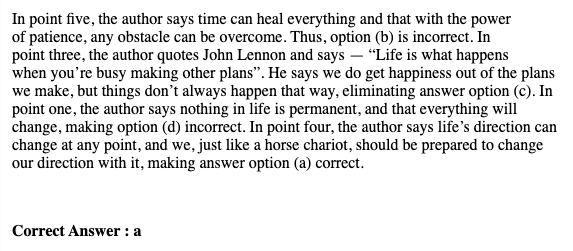
Q3. Which of the following is not true as per the passage?
- Our mind is our home, and it is the only thing we have control over.
- It is wiser to withhold hope, but being a pessimist also isn’t sensible.
- Philosophy always tells the author what the author wants to know and what the author ought to know.
- We place a great value in our possessions and experiences and the elaborate plans to acquire these possessions and experiences.
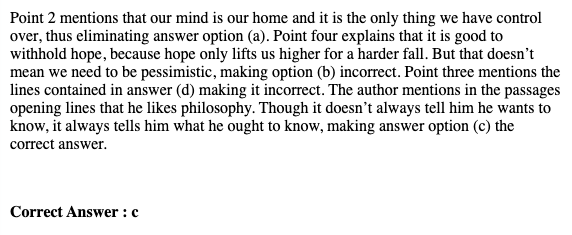
Correct Answer 1
Option D
Correct Answer 2
Option A
Correct Answer 3
Option C
Day 82 of 100: Quant - Geometry
The length of each side of an equilateral triangle ABC is 3cm. Let D be a point on BC such that the area of triangle ADC is half the area of triangle ABD. Then the length of AD, in cm, is
- √7
- √5
- √8
- √6
Correct Answer
A. √7
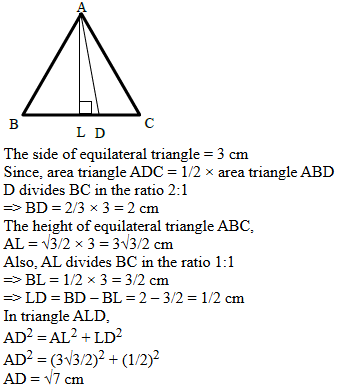
Day 83 of 100: Tip of the Day - Trust the Foundation 🤝
You have put in months of hard work, and it’s a monumental achievement in itself. As the finish line gets closer, it’s common for self-doubt to creep in and make you feel like your preparation isn’t enough. Don’t let that voice win. The remaining weeks are not about learning a new syllabus; they are about solidifying the strong foundation you’ve already built.
Take a moment to acknowledge the skills you’ve mastered and the concepts you now understand. Trust that the countless hours of practice have prepared you for this moment. Your goal now is to stay resilient, be kind to yourself, and believe in the foundation you’ve built.
Day 84 of 100: DILR Set
Nritya-Shakti is a dance academy that conducts dance classes for Bharatnatyam, Kathak and Kathakali. Each enrolled student can opt for either one dance form or two dance forms or all three dance forms. It is known that the number of students who opted for Bharatnatyam is less than the number of students who opted for Kathak, which, in turn, is less than the number of students who opted for Kathakali.
Q1. If 100 students have enrolled for Bharatnatyam, then find the minimum number of students enrolled in the dance academy.
Q2. If each student enrolls for at least two dance forms and in all 100 students opt for Kathak, then find the minimum number of students enrolled in the dance academy.
Q3. If 56 students opted for Bharatnatyam, 112 students opted for Kathak and 128 students opted for Kathakali, and maximum possible number of students opted for both Kathak and Kathakali only (but not for Bharatnatyam), then find the maximum number of students enrolled in the dance academy.
Q4. If 40 students opted for Bharatnatyam, 50 students opted for Kathak and 60 students opted for Kathakali, then what can be the minimum number of students enrolled in the dance academy?
Q5. In all 200 students have enrolled with the academy. The number of students who have enrolled in Bharatnatyam, Kathak and Kathakali are 80, 100 and 120 respectively. What can be the maximum number of students who have enrolled in only one dance form?
Correct Answer 1
102
Correct Answer 2
101
Correct Answer 3
184
Correct Answer 4
60
Correct Answer 5
150
Day 85 of 100: VARC Vocabulary
Word: Atrophy (noun or verb)
Meaning: (Of a body part or tissue) Wasting away or decrease in size, typically due to the degeneration of cells, or from disease, injury, or lack of use. (Also used figuratively to mean gradually decline in effectiveness or vigor due to underuse).
Example in a Sentence: “Because the patient’s leg was encased in a cast for months, the muscles began to atrophy from disuse.”
Synonyms: Wasting, degeneration, decline, deterioration.
Why it’s important: While often used in a medical context, the term is valuable for describing any form of decline or degradation resulting from neglect or inactivity. Figuratively, it applies to skills, institutions, or relationships that weaken when not exercised or maintained.
Day 86 of 100: Quant - Mixtures and Alligation
A container has 40 litres of milk. Then, 4 litres are removed from the container and replaced with 4 litres of water. This process of replacing 4 litres of the liquid in the container with an equal volume of water is continued repeatedly. The smallest number of times of doing this process, after which the volume of milk in the container becomes less than that of water, is
Correct Answer
7

Day 87 of 100: DILR Set
Seven persons – A through G – were standing in a queue, one behind the other, not necessarily in the same order. Among these seven persons, five persons were males and the other two were females. Further, four of them were engineers and three of them were doctors.
It is known that
- No two doctors were standing next to each other and there was at least one female engineer and one female doctor.
- G, a male doctor, was standing immediately behind a female, while C, who is a male, is standing immediately in front of a female engineer.
- E, who was not standing immediately in front of an engineer, was standing immediately behind F, who is a doctor, while C was standing behind at least two doctors.
- B is standing in front of D and there is exactly one doctor, one engineer and one female standing between the two of them.
Q1. How many persons are standing behind F?
Q2. Who among the following is a female engineer?
- E
- D
- B
- A
Q3. What is the maximum number of persons standing between any two doctors of the same gender?
Q4. Who among the following is standing immediately in front to a female doctor?
- B
- D
- C
- None of these
Correct Answer 1
5
Correct Answer 2
4. ACorrect Answer 3
2
Correct Answer 4
1. B
Day 88 of 100: VARC Verbal Reasoning
DIRECTIONS for question: Each of the following questions contains a statement followed by two arguments numbered I and II. Decide if the given argument is strong or not.
Mark your answer as:
- if only argument I is strong.
- if only argument II is strong.
- if neither argument I nor argument II is strong.
- if both argument I and argument II are strong.
Q1.
Statement:
Newspapers should restrict themselves only to an online presence.
Arguments:
I. Yes. The readership of print format newspapers is falling drastically with each passing year.
II. Yes. The revenue earned through online advertisement space is much higher than revenue earned through print advertising space.
None of the arguments are strong. The readership of the print format can still be greater than that of the online format even when it is falling drastically. Moreover, there can be readers, however few in number, who may not have access to the online format of the newspaper. Thus, the newspaper will lose this particular segment completely if it restricts itself to the online format. Argument II does not qualify as a strong argument. Even if the revenue earned through online advertising is much higher then also one cannot discount the earning though print version. This should not be the basis for a newspaper to restrict to online format only.
Q2.
Statement:
Should the usage of mobile phones be banned on roads?
Arguments:
I. No. This is a democratic country and one can use one’s own phone.
II. Yes. This will lead to a reduction in the number of freak accidents on roads.
Only the second argument is a strong one. Democracy doesn't give one to do whatever one wants to do. It comes with certain restrictions. Any action that saves human lives is considered to be a strong one. Hence, 2 is the answer.
Q3.
Statement:
Should active euthanasia be legalized for people with terminal conditions?
Arguments:
I. Yes. A man must have the right to rid himself of the agony of a prolonged condition which has no hope for cure.
II. No. The law of the land doesn’t have any option of legalizing killing.
Both the arguments are strong as both of them provide strong reasons for doing / not doing the action.
Q4.
Statement:
Should India adopt universal health care system?
Arguments:
I. Yes. Canada has reaped rich rewards by adopting this practice.
II. No. The country’s health care services will deteriorate if the government interferes.
Neither of the arguments is strong. There is no yardstick to compare Canada and India. The second argument is not related to this statement as universal healthcare is not synonymous with government interference.
Q5.
Statement:
Should India manufacture hydrogen bombs?
Arguments:
I. Yes. It will make India the strongest military aggressor in the region.
II. No. It goes against the teachings of Mahatma Gandhi, whom Indians consider as the “father of the nation”.
The first argument is vague. We must find out if becoming the strongest military aggressor is a desirable goal. This action may have catastrophic consequences for the country. The second argument is strong. One should follow the teachings of one's ideological mentor. Gandhi is clearly mentioned as the mentor of the country.
Q6.
Statement:
Is monarchy better than democracy for a large country like India?
Arguments:
I. Yes. Monarchy entails a stable form of government whereas democracy results in chaos in large countries.
II. No. The voice of the people is subverted in monarchy whereas the former reigns supreme in case of democracy.
If true, both arguments are strong. We have to assume the given argument to be true unless it goes against basic common sense.
Correct Answer 1
3
Correct Answer 2
2
Correct Answer 3
4
Correct Answer 4
3
Correct Answer 5
2
Correct Answer 6
4
Day 89 of 100: Quant - Linear Equations
The age of a son who is more than two years old. Is equal to the units digit of the age of his father. After ten years, the age of the father will be thrice the age of the son. What is the sum of the present ages of the son and the father?
- 30 years
- 36 years
- 40 years
- Cannot be determined
Correct Answer
C. 40 years

Day 90 of 100: DILR Tip - The 'Worst-Case/Best-Case' Shortcut 🎲
In sets involving maximization or minimization (e.g., minimum overlap in Venn Diagrams, maximum number of distinct values), look for the ‘worst-case’ and ‘best-case’ scenarios immediately. If a question asks for the maximum possible value of ‘X’, assume every other variable takes the smallest possible value (consistent with the constraints) to leave the most for ‘X’.
This technique drastically reduces the need to test numerous possibilities. Solving for the two extremes (min and max) often directly answers 1-2 questions and brackets the possible range for the others.
Day 91 of 100: VARC Reading Comprehension
When people think of Surrealism, they often think of Salvador Dali (1904-1989) and “The Persistence of Memory” (1931). Even in 1929, Dali’s ‘The First Days of Spring” shows a disturbing dreamland with fantastic figures, including at least one headless human.
What is important to understand is that Surrealism was global, especially as early Dada/ Surrealists like Andre Breton and Marcel Duchamp travelled the world. Surrealism occupied artists in diverse locations, including Europe, the United States, South America, and Mexico. The concept that the human mind could transcend the earthly plane was a central way to view the “absolute reality” described by Breton.
An influential Mexican painter (especially after her death), Frida Kahlo, was memorialised in the movie “Frida” starring Salma Hayek. Born in 1907 in a suburb of Mexico City, Kahlo later claimed she was born in 1910. Her life was difficult after she survived many injuries, including a streetcar accident in her mid-teens. In fact, she began to paint from the confines of a hospital bed. Later, Kahlo found many vivid experiences in her rollercoaster marriage to the artist Diego Rivera and in her friendships with artists like Georgia O’Keeffe. Her life was a series of surgeries and recoveries, and she never found a way to regain good health.
It was actually the author of the “Surrealist Manifesto”, Andre Breton, who discovered Kahlo when he visited her and Rivera in Mexico. He would introduce her to the art world as a Surrealist during her first show at the NYC gallery of Julien Levy in 1938. Although she believed her art was Realistic, her imagination (on a par with Dali’s) is evidenced in her paintings.
In 1939, Breton and Marcel Duchamp worked together to show Kahlo’s work to the Paris art establishment at the Pierre Colle Gallery. Kahlo was known for her self-portraits. In “Frida Kahlo Without Hope” (1945 – oil on canvas mounted on masonite), the artist shows herself as a victim in a hospital bed. Many angry objects are hovering over her to show the oppressive nature of hopelessness. One Surreal image is a human skull that figures prominently in the composition.
Q1. According to the passage, if Frida Kahlo believed her art was realistic why is she portrayed as a surrealist?
- Andre Breton was a surrealist.
- She had an imagination as powerful as that of Dali.
- Her works contained evidence of her surrealistic learnings.
- She was friends with Georgia O’Keeffe and many similar artists.

Q2. According to the passage, how did Frida Kahlo’s marriage to Diego Rivera affect her work?
- Her work were deeply personal accounts of her marriage.
- Her tumultuous marriage gave her experiences that fuelled her powerful imagination.
- Her tumultuous marriage gave her the experience she lacked to create powerful imagery.
- The vibrant almost living images of martial bliss at a break neck speed fuelled her powerful imagination.

- After her marriage to Diego Rivera
- Late in life
- When she was in her teens
- Cannot be determined from the passage
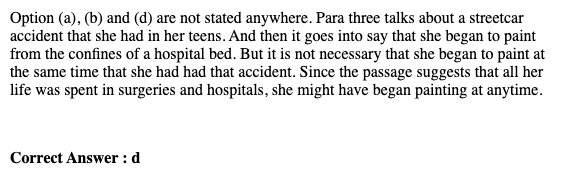
Correct Answer 1
Option C
Correct Answer 2
Option B
Correct Answer 3
Option D
Day 92 of 100: Quant - Number System
Let X be a four-digit number with exactly three consecutive digits being the same and is a multiple of 9. How many such values of X are possible?
Correct Answer
20
Day 94 of 100: VARC Vocabulary
Word: Vacillate (verb)
Meaning: Alternate or waver between different opinions or actions; be indecisive.
Example in a Sentence: “She continued to vacillate between the two job offers, unable to commit to one or the other.”
Synonyms: Waver, indecisive, hesitate, dither, oscillate.
Why it’s important: This word describes a common human trait—indecisiveness—and is often used to characterize a weak or uncertain personality in literature or historical accounts. It helps convey a sense of instability or lack of firm resolution.
Day 95 of 100: Quant - Percentage
The cost of labor in manufacturing a product is 16.66% of the total cost. Due to improvements in automation, the cost of labor decreased to 12.5% of total cost, all other cost remaining the same. Find the percentage decrease in the cost of labor.
Correct Answer
28.57%
Day 97 of 100: VARC Verbal Reasoning
DIRECTIONS for question: Each question below has a set of four statements. Each of these statements can be classified as one of the following:
- Facts, which deal with the pieces of information that one has heard, seen or read, and which are open to discovery or verification (the answer option indicates such a statement with an ‘F’)
- Inferences, which are conclusions drawn from the unknown, on the basis of the known (the answer option indicates such a statement with an ‘I’)
- Judgements, which are opinions that imply approval or disapproval of persons, objects, situations and occurrences in the past, the present or the future (the answer option indicates such a statement with a ‘J’)
Select the appropriate option as your answer.
Question 1:
A. The book says, “Repentance is the denial of one’s natural, everyday actions and regret is wishing to undo them.”
B. All people are born with a certain nature; some lean towards good and others towards evil, but we cannot change who we are.
C. If we reason and act according to the given order, then there is nothing to repent of.
D. Repentance is not necessary because we should not be held to our actions and words of the past, because our public nature is constantly changing along with our inner nature.
- FJIJ
- IFJI
- FJJI
- JIJF
Assumptions I: Non living beings are not social animals.
Assumptions II: There is at least one more living being other than man.
The statement talks about living beings only. Nothing can be assumed about non-living on the basis of the given statement. So, it is not correct to assume I. Option II is definitely true as without this being true the statement will not hold good. Option (b) is correct.
Q2.
Statement:
Child abuse is increasing and has become a major form of human exploitation in India.
Assumptions I: Children can be subjected to abuse and exploitation in India.
Assumptions II: Other forms of human sexploitation exist in India.
Both the assumptions are correct as without them the argument will not be supported. As child abuse is increasing, statement I is definitely true. 'A major form of human exploitation in India' indicates that it is not the only form of human exploitation in India.
Q3.
Statement:
Teachers have observed that children respond better in a situation where a variety of activities are taking place than in a situation with a single activity.
Assumption I: Teachers keep track of the activities of children.
Assumption II: Children take part in various activities.
Assumption I is true as without it teachers will not be able to make such an observation. Assumption II is clearly implied by the given statement in question because it states that children respond in a better way only when they find more variety. Hence, children take part in various activities.
Q4.
Statement:
People in North India wear more woollens than people in South India.
Assumption I: Good quality woolens are available more in North India than in South India.
Assumption II: People of North India are not as strong as people of South India.
Both the assumptions do not hold good. Quality of woolens does not justify the need of using them more. No assumption regarding the strength of people can be made on the basis of the need for woolens. The need depends upon climate. Thus, the valid assumption is that the climate of North India is colder than that of South India.
Q5.
Statement:
Assumption I: Personality trait is a measurable entity.
Assumption II: Personality traits are important factors with respect to performance of the job.
Assumption I is valid as it would not have been possible to measure the personality traits if it had not been a measurable entity. Since UPSC has made it a routine to measure the personality traits of the candidates, it must be important for them to measure the personality traits; hence assumption II is valid. Hence, both the assumptions follow.
Correct Answer 1
B
Correct Answer 2
C
Correct Answer 3
C
Correct Answer 4
D
Correct Answer 5
C
Day 98 of 100: Quant - Average
An elevator has a weight limit of 630 kg. It is carrying a group of people of whom the heaviest weighs 57 kg and the lightest weighs 53 kg. What is the maximum possible number of people in the group?
Correct Answer
11
Day 100 of 100: You’ve Done the Work. Now, Trust the Process.🍀✨
Today your most important job is to stop studying. Put the books away. You’ve done the work, and cramming now will only cause anxiety and burnout. Your brain needs rest to perform at its peak. Spend the day in quiet confidence: review your admit card and ID, eat a good meal, and get to bed early. This is a mental game, and you’ve trained for this moment. Trust in the countless hours you’ve invested, believe in the foundation you’ve built, and know that you are ready. The final day of preparation is not about adding more knowledge, but about bringing your best self to the starting line. All you have to do is show up and let your hard work shine.
You’re Ready. You’ve Always Been.
Good luck from Team Quantifiers!


